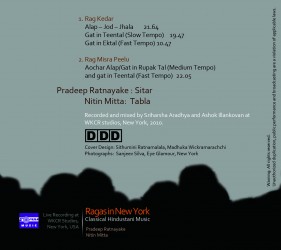In this CD I have tried to show all performing techniques and research done among all the musical styles of Sri Lanka: Indian ragas, Sri Lankan folk, Indian folk, fusion music, popular music, choral music, south Indian music. I have also experimented with Western, Sri Lankan, North Indian and South Indian instruments. The main characteristics of this music is there were no words in any of the compositions. Though this is not what Sri Lankan people are used to, those who experienced this at the BMICH gave it a standing ovation at the end.
This CD is based on North Indian Classical Ragas. I am playing two Indian ragas in the traditional style and techniques of the Maihar Gharana. The tabla accompaniment is by Nitin Mitta, Indian tablist based in New York. The rhythmic framework is rupak and teental. Here, while improvising, I play deferent layakaris, tanas and tihais.
This is a CD with light music in which I have tried to incorporate calming and relaxing sounds that can soothe stress.
I have also attempted to do so sorely through sound – so that even when voices are used, there are no words employed – be it the Sri Lankan folk voice, the North Indian voice, the South Indian voice or the Western choir – all of which find expression here.
This CD has my creative work which is based on Sri Lankan folk music or Sri Lankan traditional dance melodies like the Kuweni Asna. All these compositions were performed live at the Asia Society, New York, in 2005. I had researched to create different techniques for the sitar for this performance and introduced Kandyan drum (geta bera) to the West as a possible accompaniment to the sitar. Normally the sitar is accompanied by the tabla but I have shown that the sitar can accompanied by the gatebera.
I have also introduced a new fusion music style with all the Eastern and Western percussion. The music on this CD has been played in prestigious concert halls around the world like Carnegie Hall, New York; Walt Disney Concert Hall, California; Kennedy Center, Washington DC; BOZAR, Brussels; European Parliament, Beligium; Vienna Musikverein, Austria etc.
In this CD, I have researched and created new playing styles and techniques on the sitar. My aim was to give a Sri Lankan identity on the sitar.
The techniques:
- I have introduced Western harmony, staccato techniques and hammer guitar techniques on the sitar. Normally, the Indian sitar plays ragas and these ragas are melody patterns. Chords are things that the sitar won’t play. Strumming the sitar like a guitar and some times creating percussion effects on the sitar are techniques that I use.
- I have attempted to play blues and jazz techniques on the sitar. For that I have created new oscillating and fast vibrating (Andolan) techniques on the sitar.
The main research behind in this C .D. was to show the people that most of the Sri lankan songs were influenced by North Indian ragas. The methodology was taking people from the known to the unknown. For example, when you listen to the first item on the disk, the raga is Maand. This raga is made from a folk tune. In this Raga, the special characteristic musical phrase is S,G,GM,P,D,NP,D,P. When you listen to the song “Mal Pibidee Gena Enne” composed by Sunil Shanta, the whole song is based on this raga Maand. In this CD that is why I have selected this raga, because people will know the raga and the song both. That is what I mean by the method, known to the unknown. In this way, people can improve their level of appreciation and they will also be encouraged to listen to ragadhari music. The main idea behind this CD was to popularize North Indian ragas in Sri Lanka.
Some of these are original work I composed when I was in Columbia University, New York as a Fulbright scholar. The tabla is played by a very popular Indian tablist in New York, Nitin Mitta.
This is a symphonic Tone Poem commissioned by the Central Bank of Sri Lanka for the opening of their new Headquarters building after the old one was destroyed by a bomb blast. The theme is of a phoenix rising from the ashes. This composition tells a story and I have divided this piece into 4 movements named Peace, Conflict, Lamentation and Hope. This was performed live by an orchestra at the opening of the building in 1999.
Research was done of all the musical styles and musical instruments in Sri Lanka and almost all have been used to create this piece. I have used Western Choir, Sri Lankan folk voice, North Indian classical voice, South Indian classical voice, Western string instruments, Sri Lankan Percussion (Gata bera, Tammattama, Udakki) Indian tabla, pakawaj, South Indian percussion like Morsin, Ghatam, Mridangam; Western drums, bass guitar, the bamboo flute and so on.



